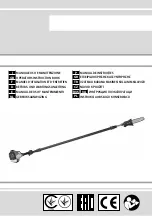
16
8.14
Auto Shut-Off Adjustment
The saw is properly adjusted when blade shuts off
just after cut completion. To set this:
•
If saw completes cut but blade continues
moving, adjust trip tab (V, Figure 8-13)
downward.
•
If blade stops before cut is complete, adjust trip
tab (V) upward.
•
If blade stops descending and continues
running without completing the cut, turn stop
bolt (W) down.
Figure 8-13: Shut-Off Adjustment
8.15
Vise Positioning
To set vise for 90 to 45 degree cutting:
1) Remove bolt and nut assemblies (F, Figure 8-
14).
2) Position vise and reinstall as shown in Figure 8-
14. Pay particular attention to bolt hole location.
3) Set vise to desired angle, reinstall nuts and
bolts, and tighten nut and bolt assemblies.
4) Adjust floating vise parallel to fixed vise by
loosening bolt (G, Figure 8-15), adjusting to
parallel, and tightening bolt.
Figure 8-14: Vise Positioning
Figure 8-15: Vise Positioning
To set vise for maximum width of stock cutting:
1) Remove nut and bolt assemblies.
2) Position vise and reinstall bolt assemblies as
shown in Figure 8-14.
9.0
Operation
9.1
Blade Break-In
New blades are very sharp and, therefore, have a
tooth geometry which is easily damaged if a careful
break-in procedure is not followed. Consult the
blade manufacturer’s literature for break-in of
specific blades on specific materials. However, the
following procedure will be adequate for break-in of
supplied blade on lower alloy ferrous materials.
1) Clamp a round section workpiece in the vise.
The workpiece should be 2 inches or larger in
diameter.
2) Set the saw on low speed. Start the cut with a
very light feed rate.
3) When the saw has completed 1/3 of the cut,
increase feed rate slightly and allow saw to
complete the cut.
4) Keep the same hydraulic cylinder setting and
begin a second cut on the same or similar
workpiece.
5) When blade has completed about 1/3 of cut,
increase feed rate. Watch chip formation until
cutting is at its most efficient rate and allow saw
to complete the cut (see
sect. 9.3, Evaluating
cutting efficiency).
6) The blade is now ready for regular service.
9.2
General Operating Procedure
IMPORTANT:
When cutting magnesium, never use
soluble oils or emulsions (oil-water mix) as water will
greatly intensify any accidental magnesium chip fire.
See your industrial coolant supplier for specific
coolant
recommendations
when
cutting
magnesium.
Summary of Contents for BHVBS-712B
Page 22: ...22 12 1 2 BHVBS 712B Bow Assembly Exploded View...
Page 27: ...27 13 0 Electrical Connections BHVBS 712B...
Page 29: ...29 NOTES...
Page 30: ...30 NOTES...
Page 31: ...31 NOTES...
















































